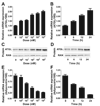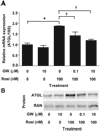PPARgamma regulates adipose triglyceride lipase in adipocytes in vitro and in vivo
- PMID: 17848638
- PMCID: PMC2819189
- DOI: 10.1152/ajpendo.00122.2007
PPARgamma regulates adipose triglyceride lipase in adipocytes in vitro and in vivo
Abstract
Peroxisome proliferator-activated receptor-gamma (PPARgamma) regulates adipocyte genes involved in adipogenesis and lipid metabolism and is the molecular target for thiazolidinedione (TZD) antidiabetic agents. Adipose triglyceride lipase (ATGL) is a recently described triglyceride-specific lipase that is induced during adipogenesis and remains highly expressed in mature adipocytes. This study evaluates the ability of PPARgamma to directly regulate ATGL expression in adipocytes in vitro and in vivo. In fully differentiated 3T3-L1 adipocytes, ATGL mRNA and protein are increased by TZD and non-TZD PPARgamma agonists in a dose- and time-dependent manner. Rosiglitazone-mediated induction of ATGL mRNA is rapid and is not inhibited by the protein synthesis inhibitor cycloheximide, indicating that intervening protein synthesis is not required for this effect. Rosiglitazone-mediated induction of ATGL mRNA and protein is inhibited by the PPARgamma-specific antagonist GW-9662 and is also significantly reduced following siRNA-mediated knockdown of PPARgamma, supporting the direct transcriptional regulation of ATGL by PPARgamma. In vivo, ATGL mRNA and protein are increased by rosiglitazone treatment in white and brown adipose tissue of mice with and without obesity due to high-fat diet or leptin deficiency. Thus, PPARgamma positively regulates ATGL mRNA and protein expression in mature adipocytes in vitro and in adipose tissue in vivo, suggesting a role for ATGL in mediating PPARgamma's effects on lipid metabolism.
Figures






Similar articles
-
Regulation of adipose triglyceride lipase by rosiglitazone.Diabetes Obes Metab. 2009 Feb;11(2):131-42. doi: 10.1111/j.1463-1326.2008.00916.x. Epub 2008 Jul 17. Diabetes Obes Metab. 2009. PMID: 18643838 Free PMC article.
-
Peroxisome proliferator-activated receptor-gamma ligands inhibit adipocyte 11beta -hydroxysteroid dehydrogenase type 1 expression and activity.J Biol Chem. 2001 Apr 20;276(16):12629-35. doi: 10.1074/jbc.M003592200. Epub 2001 Jan 22. J Biol Chem. 2001. PMID: 11278270
-
Peroxisome proliferator-activated receptor-gamma regulates the expression and function of very-low-density lipoprotein receptor.Am J Physiol Endocrinol Metab. 2010 Jan;298(1):E68-79. doi: 10.1152/ajpendo.00367.2009. Epub 2009 Oct 27. Am J Physiol Endocrinol Metab. 2010. PMID: 19861583 Free PMC article.
-
Coordinated transcriptional control of adipocyte triglyceride lipase (Atgl) by transcription factors Sp1 and peroxisome proliferator-activated receptor γ (PPARγ) during adipocyte differentiation.J Biol Chem. 2017 Sep 8;292(36):14827-14835. doi: 10.1074/jbc.M117.783043. Epub 2017 Jul 18. J Biol Chem. 2017. PMID: 28726642 Free PMC article.
-
Adipogenesis and lipotoxicity: role of peroxisome proliferator-activated receptor gamma (PPARgamma) and PPARgammacoactivator-1 (PGC1).Public Health Nutr. 2007 Oct;10(10A):1132-7. doi: 10.1017/S1368980007000614. Public Health Nutr. 2007. PMID: 17903321 Review.
Cited by
-
Interplay of FXN expression and lipolysis in white adipocytes plays a critical role in insulin sensitivity in Friedreich's ataxia mouse model.Sci Rep. 2024 Aug 27;14(1):19876. doi: 10.1038/s41598-024-71099-7. Sci Rep. 2024. PMID: 39191875 Free PMC article.
-
Effect of treatment with conditioned media derived from C2C12 myotube on adipogenesis and lipolysis in 3T3-L1 adipocytes.PLoS One. 2020 Aug 5;15(8):e0237095. doi: 10.1371/journal.pone.0237095. eCollection 2020. PLoS One. 2020. PMID: 32756599 Free PMC article.
-
Effects of Aloe arborescens Whole Plant Homogenate on Lipid Metabolism, Inflammatory Conditions and Liver Function of Dairy Cows during the Transition Period.Animals (Basel). 2020 May 25;10(5):917. doi: 10.3390/ani10050917. Animals (Basel). 2020. PMID: 32466290 Free PMC article.
-
Trichostatin A modulates thiazolidinedione-mediated suppression of tumor necrosis factor α-induced lipolysis in 3T3-L1 adipocytes.PLoS One. 2013 Aug 9;8(8):e71517. doi: 10.1371/journal.pone.0071517. eCollection 2013. PLoS One. 2013. PMID: 23951179 Free PMC article.
-
Coordinated alteration of mRNA-microRNA transcriptomes associated with exosomes and fatty acid metabolism in adipose tissue and skeletal muscle in grazing cattle.Asian-Australas J Anim Sci. 2020 Nov;33(11):1824-1836. doi: 10.5713/ajas.19.0682. Epub 2019 Dec 24. Asian-Australas J Anim Sci. 2020. PMID: 32054170 Free PMC article.
References
-
- Arimura N, Horiba T, Imagawa M, Shimizu M, Sato R. The peroxisome proliferator-activated receptor gamma regulates expression of the perilipin gene in adipocytes. J Biol Chem. 2004;279:10070–10076. - PubMed
-
- Baulande S, Lasnier F, Lucas M, Pairault J. Adiponutrin, a transmembrane protein corresponding to a novel dietary- and obesity-linked mRNA specifically expressed in the adipose lineage. J Biol Chem. 2001;276:33336–33344. - PubMed
-
- Bays H, Mandarino L, DeFronzo RA. Role of the adipocyte, free fatty acids, and ectopic fat in pathogenesis of type 2 diabetes mellitus: peroxisomal proliferator-activated receptor agonists provide a rational therapeutic approach. J Clin Endocrinol Metab. 2004;89:463–478. - PubMed
-
- Bogacka I, Ukropcova B, McNeil M, Gimble JM, Smith SR. Structural and functional consequences of mitochondrial biogenesis in human adipocytes in vitro. J Clin Endocrinol Metab. 2005;90:6650–6656. - PubMed
-
- Bogacka I, Xie H, Bray GA, Smith SR. Pioglitazone induces mitochondrial biogenesis in human subcutaneous adipose tissue in vivo. Diabetes. 2005;54:1392–1399. - PubMed
Publication types
MeSH terms
Substances
Grants and funding
LinkOut - more resources
Full Text Sources

